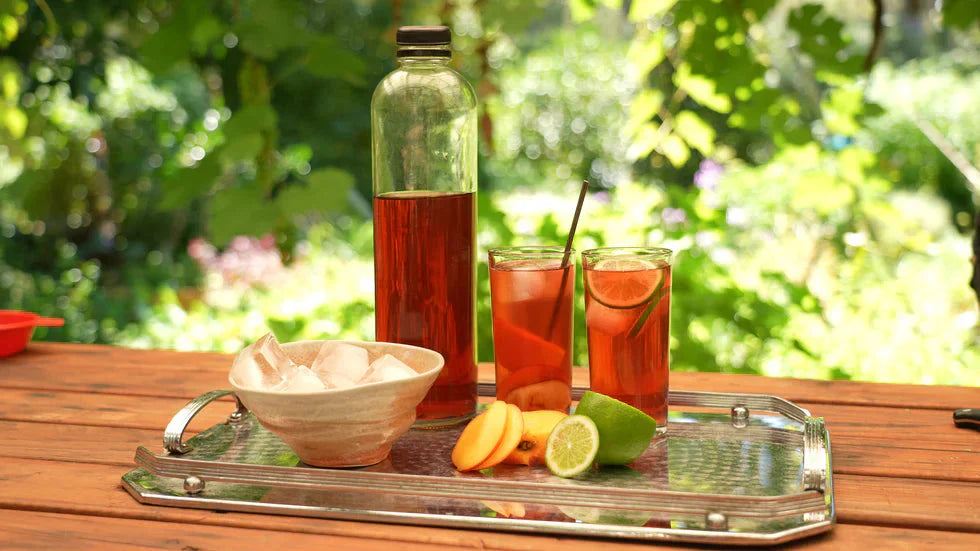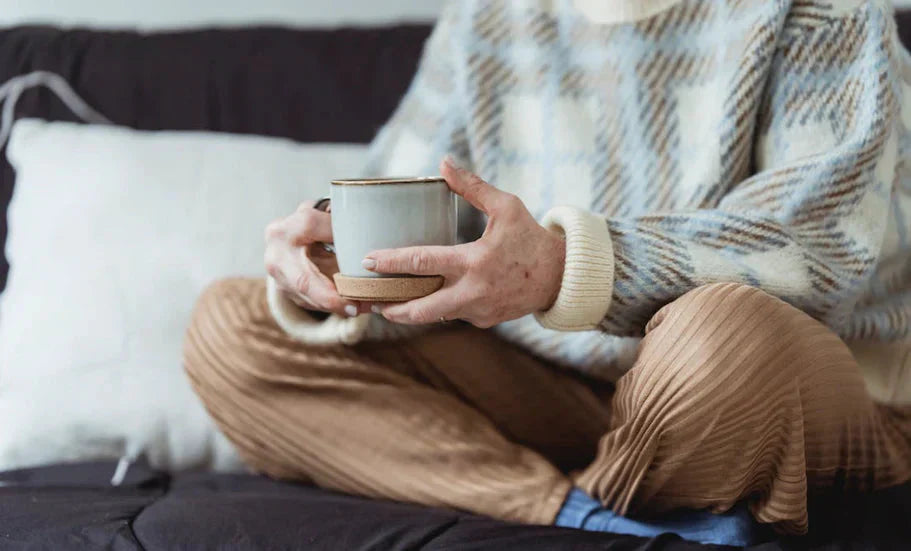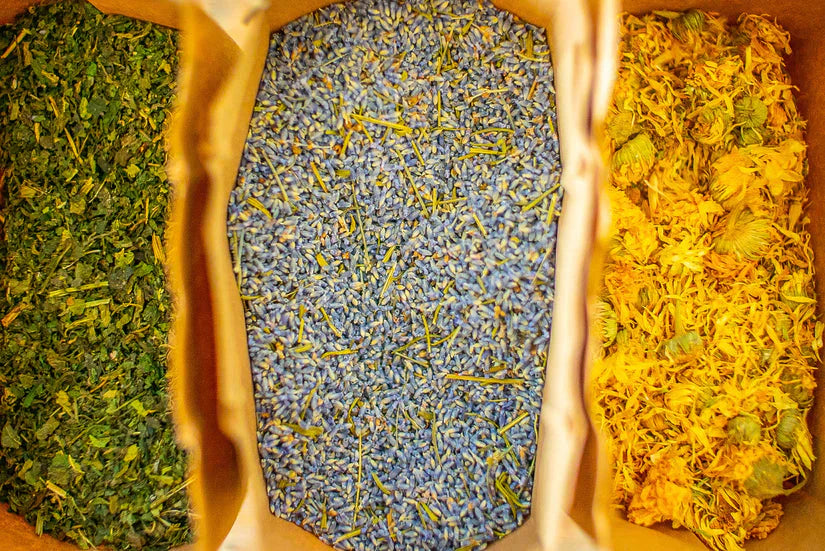Latest In Blog

Latest In Blog
door digitalR 10X op mrt. 13 2025
Herbal Teas or Tisanes are prepared as an infusion and can be made from a single herb or a blend of herbs. They can be drunk as a hot or cold enjoyable beverage or simply for the herbs’ medicinal effect.
My favourite Iced Tea recipe for summer is a mix of fragrant Rose, Lemon Balm, Rosella and Raspberry Leaf! Check out the recipe below.
There's nothing quite like a cooling iced tea on a hot summers day - and if it has the added herby benefits, well yummo that's a bonus!
Directions
1. In a bowl, mix the dried herbs together. This can then be stored in an airtight container, in a cool dark spot for future use.
2. To make Iced Tea that serves 4, place 2tbsp of the dried herb mix into a teapot and cover with 4 cups of boiling water.
3. Let it infuse for 5-10 minutes.
4. Pour straight into a bottle, and let it cool slightly before putting it in the fridge to chill.
5. Once chilled, serve in a glass with ice and couple of slices of lime.
6. If you like it a bit sweeter and fruitier add fresh peach slices or even some peach juice.

Latest In Blog
Health Benefits of Jilungin Sleep Tea
door digitalR 10X op mrt. 13 2025
Are you struggling to get a good night's sleep, constantly tossing & turning until the alarm goes off? You’ve probably tried a handful of natural sleep remedies, or at least researched a few of them. One of the simplest ones seems to slip under the radar: Jilungin Sleep Tea.
This herbal tea has been used for millennia by Indigenous Australians because of the sleep benefits that it offers. Jilungin Sleep Tea will improve your sleep quality and help you fall asleep faster, even if you have sleep disorders like insomnia and sleep apnoea. So if you’re ready to explore the benefits of Jilungin Tea and finally sleep a full 8 hours every night, let’s get ready for bed!
What is Jilungin Tea?Jilungin Tea, or more simply known in Australia as "Sleep Tea," is an herbal infusion made from the leaves of the Jilungin plant (Terminalia canescens). You may know the shrub-like plant by its common names, such as joolal, winged nut tree, and wingnut. It’s native to the Northern Territory, particularly the Kimberley region, and has been consumed by Aboriginal peoples for centuries, particularly as a tea.
Indigenous Roots and Traditional UsesThe Aboriginal people would harvest the leaves of the Jilungin plant and brew them into a tea, which they believed had various health-promoting properties. Traditionally, Jilungin tea was used to treat insomnia, anxiety, and other sleep-related issues, but it was also believed to have calming and soothing effects on the body and mind. As far as herbal tea blends go, this single herb tea is one of the most effective at minimising stress & anxiety and promoting relaxation before bed.
Herb ProfileThe Jilungin plant is a small shrub that grows up to three metres in height. It has distinct elliptical leaves with a glossy appearance and a pale green colour. The leaves have an earthy aroma, similar to citrus and eucalyptus. The plant is rich in bioactive compounds such as flavonoids, tannins, and polyphenols, which contribute to its sleep-inducing abilities.
Jilungin tea is typically prepared by steeping dried, crushed leaves of the Jilungin plant in hot water for several minutes. This allows the beneficial compounds to infuse into the water, creating a flavourful and aromatic beverage.
Documented Health Benefits of Jilungin Sleep TeaAs with most herbal teas, it’s full of antioxidants, more so than commercial-grade green tea, according to a Queensland-based study. The primary benefits of Jilungin Sleep Tea are directly related to sleep, specifically its ability to help you fall asleep faster, manage sleep disorders, and improve overall sleep quality.
Improved Sleep QualityUsers have reported experiencing a deeper and more restful sleep after consuming Jilungin Tea regularly. This may be attributed to the calming and soothing effects of the tea, which can help relax the mind and body before bedtime.
Here are what a few Herb Cottage customers had to say about our wildcrafted Jilungin Sleep Tea:
“I have trouble getting to sleep. Found this product does seem to help better than the other common remedies (warm milk, Valerian and other pills, no screen time etc.).” – Niall R.
“This is my favourite sleep aid and works - fantastic to be able to source reliably.” – Melita J.
“I always have trouble getting a solid night sleep and this has helped me sleep right through.” – Jason D.
Fall Asleep FasterFor those who struggle with falling asleep quickly, Jilungin tea may offer some relief. The herbal infusion has been known to promote faster sleep onset, helping individuals drift off into a peaceful slumber more easily. This is particularly beneficial for those who struggle to unwind after a long, stressful work day, have trouble falling asleep after blue light exposure, or have been diagnosed with insomnia. Each of these keeps you from resting, which is one of the most important elements of a healthy lifestyle.
Manage Sleep DisordersSleep disorders like insomnia and sleep apnoea are medical conditions that negatively impact sleep quality over a period of time. While you may be able to recover from one or two nights of poor sleep, these conditions tend to make life increasingly difficult as your hours of shut eye are cut short.
A person with insomnia has trouble falling asleep, staying asleep, or sometimes, both. If you can’t consistently rest your mind & body, your daytime functionality and mood will be impaired. Sleep apnoea, on the other hand, is a condition where breathing repeatedly stops and starts during sleep. And while there are medications and equipment that can be used to manage these disorders, they aren’t optimal, especially if you share a room with your partner.
Relaxation and Stress ReductionStress and anxiety are two of the greatest contributors to poor sleep quality. Jilungin tea is believed to have calming properties, helping to reduce stress levels and promote relaxation. A singular cup of tea before bed can help melt the stress & anxiety of the day away, calming your body for a full 8 hours of rest.
While it may not be a standalone solution, incorporating Jilungin Tea into your holistic health routine, particularly before bed, may contribute to better sleep patterns and overall sleep management
How Does Jilungin Tea Help You Sleep Better?If you're curious about how Jilungin tea works to improve sleep quality, you're not alone. While the exact mechanisms are not yet fully understood, there are several ways in which Jilungin tea is believed to help promote better sleep:
Calming and Relaxing EffectsJilungin tea is known for its calming and relaxing effects on both the mind and body. It contains bioactive compounds that may have a sedative-like effect, helping to reduce anxiety and promote a sense of tranquillity. By calming the nervous system, Jilungin tea can help prepare the body for restful sleep.
Regulation of Sleep HormonesSleep is regulated by various hormones in the body, primarily melatonin and cortisol. Melatonin is responsible for promoting sleep, while cortisol is associated with wakefulness and stress. Jilungin tea is believed to help regulate the production and release of these hormones, promoting a balanced sleep-wake cycle and supporting healthy sleep patterns.
Reduction of InflammationInflammation in the body can disrupt sleep patterns and contribute to sleep disturbances. Jilungin tea is known to possess anti-inflammatory properties, which can help reduce inflammation and oxidative stress, two primary drivers of sleep disorders.
Regulation of NeurotransmittersNeurotransmitters play a crucial role in regulating sleep and wakefulness. Some studies suggest that Jilungin tea may have an impact on neurotransmitter activity, potentially influencing sleep-related neurotransmitters such as GABA (gamma-aminobutyric acid) and serotonin. These neurotransmitters are involved in promoting relaxation and regulating sleep, and their balance is essential for healthy sleep patterns.
How to Use Jilungin Sleep TeaEven though a full night of sleep might feel impossible right now, it’s only a few cups of Jilungin Tea away. We’re going to share our best tips and insights to help you finally get some rest.
When & How Much to ConsumeWe recommend that you consume a singular glass at least 60 minutes before bed to avoid any toilet visits that will disrupt REM sleep. Stick to this routine for at least two weeks in order to improve your sleep quality at night and energy levels throughout the day.
As for the quantity, start with a small amount and gradually increase it to find the right dosage that works for you.
We suggest crushing 2 or 3 leaves, bark, and/or twigs in the palm of your hand, then infusing in a short cup (200ml) of boiling water for 10 minutes. Your individual tolerance and sensitivity may vary from others, so make sure to listen to your body and adjust accordingly.
Want to make the perfect cup of Jilingun Sleep Tea? Check out our infusion guide.
Combine with Other Relaxation TechniquesJilungin Sleep Tea can be a vital addition to your nighttime routine, but it’s best combined with other techniques. If you’ve had a long, stressful day, one cup of tea might not be enough to put you to sleep. But when combined with other relaxation methods such as meditation, deep breathing exercises, gentle stretching, or essential oils, rest assured that your sleep quality will steadily improve.
Along with relaxation techniques, make sure that your bedroom environment helps your body prepare for bed. These are some of the most common techniques recommended by sleep experts:
Turn on the air con or a fan to lower the temperatureUse blackout curtains and a sleep mask to block out external lights and internal lights from certain appliancesAvoid exposure to blue light (phone, tablet, TV, and computer) for at least 60 minutes before bedStick to a consistent sleep schedule, even on the weekendsCombined with Jilungin Sleep Tea, nothing will disturb your sleep.
Considerations and PrecautionsAs with anything that you consume, it’s important to take the necessary considerations and precautions.
Individuals with known allergies or sensitivities to plants in the Combretaceae family, to which the Jilungin plant belongs, should exercise caution when consuming Jilungin tea. Or if you have a history of allergic reactions to plants or herbal remedies, be sure to consult with your doctor or holistic practitioner before consuming.
As a general rule of thumb, you should start with a lower dosage and progressively increase the dosage as your body adjusts to the effects. We’re not suggesting that you should consume as much as possible, but some individuals will require more than others to reap the benefits. Pay attention to how your body reacts in the first 60 minutes and how your sleep quality is affected, then make adjustments as needed.
There are a number of sleep benefits associated with Jilungin Sleep Tea, which is why it’s nicknamed “Australian Sleep Tea.” When used properly, it can help you fall asleep faster and stay asleep throughout the night, without causing grogginess the next morning. Many people have reported improvements in quality of sleep, including entire Indigenous populations. Ready to finally get your sleep schedule back on track? Grab your bag of Jilungin Tea today.

Latest In Blog
door digitalR 10X op mrt. 13 2025
Fresh herbs are generally tastier than dry herbs. They add life, colour and a fresh taste that dried herbs cannot deliver.
So why dry them? There are many herbs that just don't hang around all year. Drying herbs allows you to enjoy them after they are long gone or while they are taking their winter break.
When dried, some herbs still keep an excellent flavour. Dried Greek Oregano adds so much flavour to a rich tomato sauce and some would say it works better than fresh.
Chillies are great to have on hand in their dried form to add a fiery zing to many different dishes. Dried Chives add a delicate onion flavour to soup, mashed potato or eggs.
Many medicinal herbs die back in winter, such as Echinacea, Astragalus, Turmeric, Ginger and Chaste tree berries. These can be stored dried for up to two years. Giving you medicine when the plant is sleeping.
Harvesting, Drying and Storing Herbs
Harvesting Herbs
The best time to harvest your herbs for drying is mid-morning. After the dew has dried and before the heat of the sun has wilted them, this will help to keep their scent and colour.
Harvest herbs when the oils responsible for flavour and aroma are at their peak. When choosing the best time to harvest a particular plant, consider the part of the plant you will be using.
Leaves are best cut from the bush before the plant has flowered. Cutting back the stems by approximately a third. This allows for regrowth of the plant in most cases.
Flowers are at their best picked when most of the flowers have opened.
Seeds can be collected when the majority are ripe.
Roots and rhizomes are usually dug in Autumn. Or when the aerial growth has started to wilt and die and the energy has retreated to the roots. Some roots can also be dug in spring when they have begun to shoot.
Drying Herbs
To dry herbs, you need the circulation of warm, dry air.
Choose a suitable place in your house that has good airflow and is not too bright.
AVOID – sun, strong light, moisture and steam.
Hang small bunches of herbs. Remove the lower leaves off stems and bundle 4-6 stems together. Secure with a rubber band or string. Air needs to move around the herbs to avoid mould.If you have concerns about light or dust, you can place the herb bunches in a brown paper bag.Poke the stems through the base of the paper bag and pull the bag down around the leaves. The bottom of the bag left open, and a few holes in the sides to help with the airflow.
Open trays such as a cane basket, jumper dryer, or a rack made from a screen are all suitable to dry herbs.Line the surface with tissue paper or breathable natural fabric. Remove the leaves from the stems and spread over the surface allowing for airflow. Turn the leaves daily to ensure even drying.
Drying herbs using the above two methods can take from as little as three days and up to 2 weeks. Check herbs daily. Herbs are ready when the leaves crunch between your fingers.
Rhizomes and roots Clean, wash and pat dry the roots. Chop into small pieces. The smaller the pieces, the quicker they dry. Spread onto open trays as suggested above and turn daily.
Oven drying. After baking, use the warmth of the oven. Turn the oven off and let it cool down a bit. Place herbs on a lined baking tray and pop in the oven, leaving the door open. You do not want the oven hot, or the herbs will lose their essential oils, scent and flavour. Turn the herbs to ensure even drying.
Using a dehydrator is a fast, effective way to dry herbs. This is my favourite method. The controlled temperature and air circulation make for quick, well-dried herbs. Herbs can take between 4 and 12 hours to dry in a dehydrator. Set the temperature below 40° celsius. When purchasing a dehydrator, look for one that has a temperature control that goes down as low as 35°C.
When the herbs have dried completely, they should crumble when touched. Try to leave dried herbs as complete as possible, only crumbling or powdering them before use. This helps keep them fresh for longer.
Storing Dried Herbs
Store them in a glass jar with a tight-fitting lid. Label and date the jar before putting it in a dark, cool position. If dried and stored well, your herbs will last for up to two years.
Harvested herbs can also be frozen. Freezing your herbs retains the nutrients, flavour and smell. You can freeze your herbs in a container or even in an ice cube tray for easy addition to your cooking.
